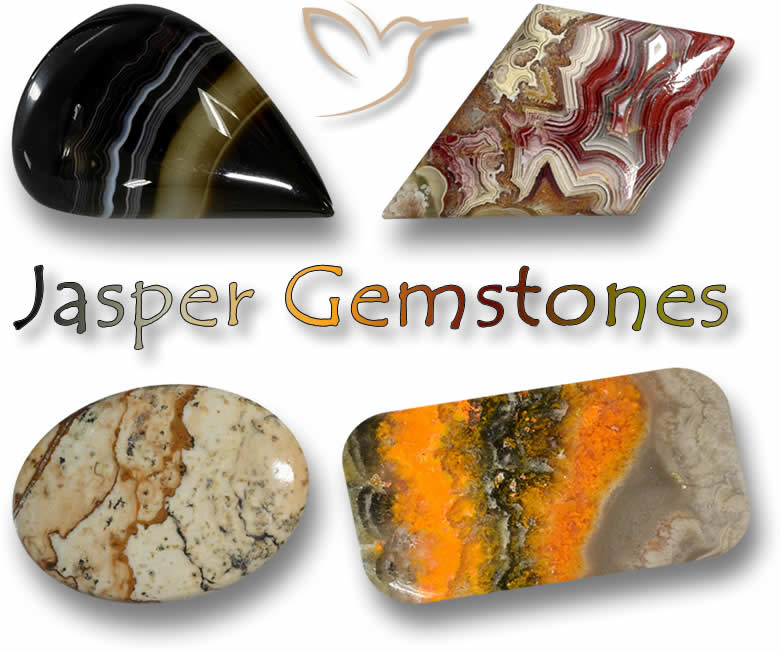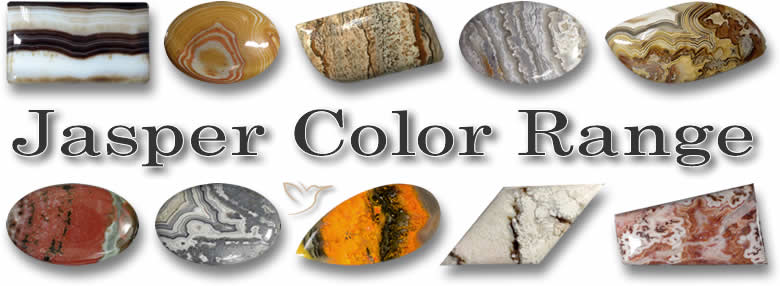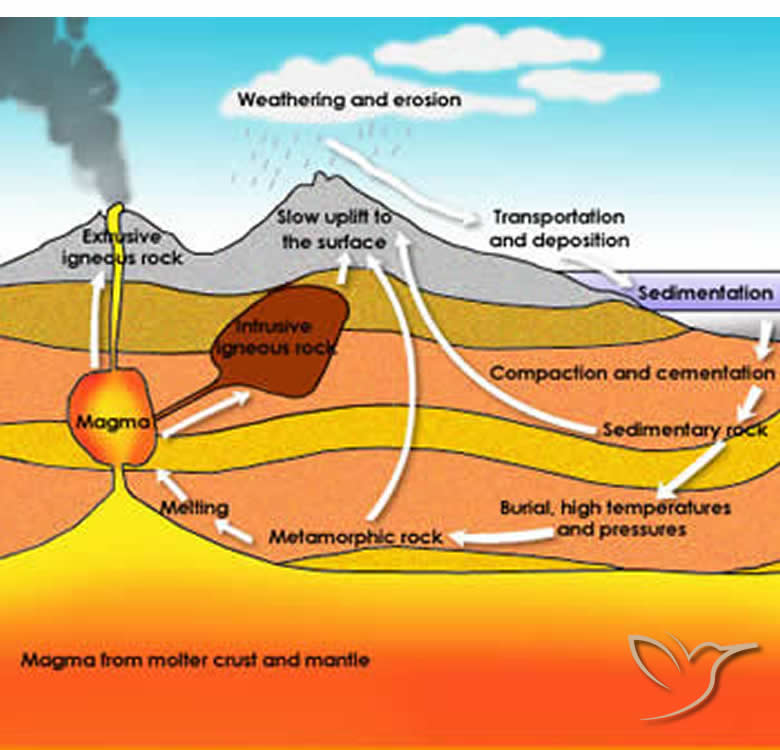Jasper Gemstone Information

Jasper Introduction
The word Jasper means spotted or speckled stone, and once you take a peek at the vast array of gemstones grouped under this name, it makes perfect sense. With swirling designs, flecks of color, splashes of red, green, and yellow, plus those woody or natural-looking patches, this gem truly stands out as one of a kind.
These distinctive colors and patterns, combined with its toughness and ability to take a shine, have made it a beloved gem for thousands of years - think Ancient Egyptians and Greeks. It pops up in the Bible multiple times and was shaped into tools, seals, beads, and decorations from the Harappan civilization in the Indus Valley to the Minoan culture on Crete.
Back in the day, it was seen as super rare and valuable, often mixed up with stones like jade, nephrite, or carnelian. These days, thanks to science, we can spot it more accurately (though it's still a bit sneaky), and with finds all over the globe, it's pretty budget-friendly - yet just as stunning.
Jasper Colors

Jasper gemstones can appear in nearly any shade, but they often lean toward those warm, natural tones like reds, browns, oranges, yellows, and greens. Blues and purples aren't impossible, either. And here's the fun part - it's rarely just one color; you'll typically see two, three, or more hues mingling on a single stone.
As a variety of chalcedony, Jasper includes up to 20 percent other materials, which are responsible for its colorful diversity. Iron is the usual suspect, lending those red, brown, and yellow shades. Oxidized iron can turn it green, while manganese brings in blues. Other elements like oxides, metals, or even bits of organic matter mix in during formation, creating all kinds of shades and motifs.
In the gem world, color matters a lot - vibrant or rare hues in Jasper will fetch more than muted ones (though someone might love those subtler tones). But overall, Jasper stays affordable, so even top-notch colors won't break the bank.
Jasper Species
Sorting out Jasper types can get a tad tricky, so let's break it down with a quick geology primer.
Quartz consists of silicon and oxygen, coming in two forms: macrocrystalline with big crystals (like amethyst or citrine) and microcrystalline with tiny ones (like chalcedony). Jasper falls into the chalcedony category, alongside close relatives such as agate, carnelian, and onyx.
Macrocrystalline quartz is often transparent or translucent, while microcrystalline types are usually translucent to opaque. Jasper is firmly in the opaque camp.
Jasper gets subdivided further by color, pattern, and source, leading to thousands of names. It's straightforward with ones like yellow Jasper, red Jasper, green Jasper, zebra Jasper (black and white stripes), or leopard Jasper (mottled spots).
Bumblebee Jasper, with its striking black and orange bands, isn't actually Jasper at all. Other true varieties include jaspilite, poppy, and brecciated Jasper.
Some are named after their origins, like:
- Brazilian Jasper - featuring green patches
- African Jasper - known for dark tones
- Russian Jasper - often with reddish spots
Things get more specific with local names:
- Biggs Jasper - muted gold, brown, and ebony with a wood-like vibe from Oregon
- Bruneau Jasper - caramel and cream layers from Idaho
- Morgan Hill Jasper - red and yellow circles from California
Then there are picture Jaspers that look like scenic views:
- Owyhee Jasper - desert scenes with blue skies from the Rockies
- Dendritic Jasper - feathery designs from ancient sea life
- Flame Jasper - swirls of red and orange
Dalmatian Jasper is another common mix-up - it's not Jasper either. The endless varieties highlight Jasper's diverse colors, patterns, and styles. These labels help when hunting for a specific look, but at its core, Jasper is a beautiful, multicolored gem.
Jasper Clarity and Cut

Gemstones generally fit into three clarity groups: opaque (no light passes through), translucent (some light gets in but not clearly), or transparent (light flows freely, letting you see through). Jasper is opaque - you can't see through it at all.
Because of that, it's typically cut into smooth, rounded cabochons and polished to a gloss. The captivating colors and swirls in some pieces make them ideal for carving into freeform or unusual shapes, perfect for standout jewelry.
Though classified as opaque, Jasper's many impurities can blur the line - some areas might seem slightly translucent, or edges could let a bit of light peek through. It's all part of what makes it interesting, right?
What is the spiritual meaning of Jasper?
Disclaimer: The information regarding the metaphysical properties of gemstones is provided for informational purposes only. It is not intended to be a substitute for professional advice or treatment.
Jasper is a chalcedony quartz with up to 20 percent impurities, so its spiritual qualities vary by stone, each bringing unique energies.
That said, it has some core traits. Known as the 'Nurturing Gemstone,' it supports growth in all areas of life, whether personal or work-related.
Jasper promotes relaxation and calm, making it great for busy folks. Try meditating with it or just holding one while chilling - it clears mental clutter and refreshes you.
Its ancient ties to humanity highlight its sacred, protective side. Carved into amulets for priests and rulers, buried with mummies for the afterlife, used by Native Americans in rain rituals, or as dowsing tools for water.
Jasper and the Chakras
Disclaimer: The information regarding the metaphysical properties of gemstones is provided for informational purposes only. It is not intended to be a substitute for professional advice or treatment.
Chakras are your body's energy hubs, also called Qi or Prana. There are seven: Crown (purple), Third Eye (indigo), Throat (blue), Heart (green), Solar Plexus (yellow), Sacral (orange), and Root (red). Jasper's dominant color influences which chakra it affects most.
With its earthy tones, Jasper often links to the Root Chakra, tied to home, security, and basics. If you're stressed about work, housing, or relationships, this stone could help ground you.
If it's vividly yellow or green, it might sway the Solar Plexus or Heart Chakras instead.
Health Benefits of Jasper
Disclaimer: The information regarding the healing properties of gemstones is provided for informational purposes only. It is not intended to be a substitute for professional medical advice or treatment.
Jasper's mix of minerals can address various issues, often linked to internal organs like revitalizing liver, spleen, or kidney tissue. It may ease stomach woes, heartburn, acid reflux, or urinary infections.
The link between mind and body is clear, and Jasper's calming effect can foster emotional stability that supports physical health.
We're no experts on crystal use for wellness, but wearing it as jewelry is a simple way to keep it close. Carry it in your pocket as a touchstone, hold it during meditation, or place stones aligned with chakras while resting.
Clean Jasper every couple of weeks with tepid water and sun drying for an hour. Varieties differ, so avoid salt or fire for some types.
Jasper Price
Jasper Price List |
||
|
Color |
Weight range |
Price range / USD |
|---|---|---|
|
All colors |
1ct + |
$0.2 - 3.0/ct |
Jasper is budget-friendly and widely available, with only standout pieces commanding higher prices. Brighter colors or intriguing patterns, like landscape scenes, boost value a bit.
Cut or carving also factors in - skilled shaping to highlight features can add a touch to the cost, but it remains accessible.
This low price point makes it a go-to for hobby jewelers: unique looks, big sizes, and affordability spark creative projects.
See more Odd Shaped Gemstone for Jewelry Making here.
Jasper Discovery and History

Jasper has served as a gem, ornament, and tool material throughout recorded history, from early Indus Valley cities back to Neolithic beads.
Some of the oldest mines, in Pennsylvania, USA, show Paleolithic people - ancestors of Native Americans - extracting Jasper for weapons and jewelry around 12,000 years ago!
In Sumeria, cradle of Western civilization, Ur's residents (circa 2000 BCE) viewed the sky as a Jasper dome dotted with stars, inspired by its spots.
Museums worldwide display ancient Jasper artifacts: Roman and Minoan seals, sword hilts, amulets, and bow-drill tips.
The term entered English in the 14th century from French 'jaspre,' Latin 'jaspis,' and Greek 'iaspis,' all denoting spotted stones. Biblical Hebrew 'yashpeh' means 'to polish,' referring to valued gems.
Where is Jasper found?

Jasper appears worldwide in many forms, with varieties named after sources - like Biggs or Cave Creek Jasper ideally from those spots.
Key suppliers include India, Australia, Venezuela, Russia, Brazil, and Uruguay. Madagascar yields ocean Jasper, Indonesia multicolored types, and the USA diverse, unique varieties.
How is Jasper formed?

Like many gems, Jasper starts as magma rising to Earth's crust, cooling into rock. Gas bubbles, cracks, and overlaps create voids.
Silica-rich fluids fill these, depositing quartz over eons. Impurities - up to 20 percent - like iron or manganese add colors and patterns.
Hydrothermal reheating can warp structures into swirls. Jasper might blend with rocks or gems like agate during this.
Volcanic ash or organic matter influences markings. Harder than surrounding rock, Jasper weathers out, ending up in rivers for miners to find millions of years later.
Can Jasper be treated?
Jasper typically just gets cut and polished - no enhancements needed. Rare dyeing occurs for color or pattern boost, but its low cost makes it uncommon.
Fakes are scarce, but watch for plastic or glass knockoffs from shady sellers.
GemSelect always discloses treatments on our stones.
What Jewelry is Jasper suitable for?
At about 7 on Mohs scale, Jasper is tough enough for most jewelry. It's an ancient favorite, so you're in good company using it.
Often cabochon-cut into ovals or domes, but also carved freeform for custom pieces. Affordable, so get creative with its colors and patterns.
Big sizes and unique traits make it ideal for artisans - no two pieces match.
Did you know? Fascinating facts about Jasper
- Checking the purity of gold
- Black Jasper was once used as a 'touchstone' to determine the quality of gold or silver. The gold alloy would be rubbed onto the black Jasper and the streak compared with others of known purity.
- Christians believe the rock upon which St Peter built his church was made of Jasper.
- Jasper can be found on every continent in the world.
- Even older than we thought
- Primitive stone axes made from Jasper have been found in Omo Valley in Ethiopia and dated to 2.5 million years old.
- Bloodstone is a type of Jasper and is the birthstone for March.
- Jasper is also a mystical birthstone for October.
How to care for Jasper
As a hardy quartz, Jasper cleans easily with warm soapy water and a soft brush. Avoid harder scrubbers.
Skip household chemicals, and no prolonged heat or steam cleaners to prevent damage.
Store in a fabric-lined box or soft cloth. At 7 on Mohs, separate from softer or harder gems to avoid scratches.
How can you tell a real Jasper?

Buying from trusted sellers is key, but when hunting deals, a few checks help.
At 7 on Mohs, it resists knife scratches and scores glass (test discreetly!).
Dense quartz feels heavy and stays cool in hand.
To distinguish from agate: no light passes through Jasper - even edges. (Exceptions exist due to impurities!)
This isn't exhaustive, but useful. GemSelect guarantees our descriptions, with returns for peace of mind.
What is so special about Jasper?
Jasper is affordable yet steeped in history and prestige. It bridges our ancient past - back to early humans - and today's love for personal, original style.
Turn one in your hand, and its design, color, and uniqueness shine, forged by Earth's forces over ages, infusing a sense of connection.
Can Jasper change color?

Some gems shift colors dramatically under lights - like garnet red indoors, green outside. This happens in alexandrite, garnet, or certain sapphires, but not Jasper.
Jasper - Gemological Properties
|
Chemical Formula: |
SiO2 - Silicon dioxide |
|
Crystal Structure: |
Trigonal - microcrystalline aggregate |
|
Color: |
All colors, mostly striped or spotted |
|
Hardness: |
6.5 to 7 on the Mohs scale |
|
Refractive Index: |
1.54 (approximate) |
|
Density: |
2.58 to 2.91 |
|
Cleavage: |
None |
|
Transparency: |
Opaque |
|
Double Refraction or Birefringence: |
None |
|
Luster: |
Dull, vitreous |
|
Fluorescence: |
None |
Frequently Asked Questions
What colors does Jasper come in?
Jasper appears in earthy tones like reds, browns, oranges, yellows, and greens, often with multiple colors on one stone. Blues and purples are rarer.
What are some popular Jasper varieties?
Varieties include red Jasper, zebra Jasper, picture Jasper, and location-based ones like Biggs or ocean Jasper, each with unique patterns.
Is Jasper transparent or opaque?
Jasper is opaque, meaning no light passes through, though impurities can make some areas seem slightly translucent.
What is the spiritual significance of Jasper?
It's called the 'Nurturing Gemstone,' aiding relaxation, protection, and personal growth, with ancient uses in amulets and rituals.
Which chakras does Jasper influence?
Mainly the Root Chakra for grounding, but yellow or green varieties affect the Solar Plexus or Heart Chakras.
What are the health benefits associated with Jasper?
It's linked to organ rejuvenation and digestive relief, plus emotional calm that supports overall well-being.
How much does Jasper cost?
Typically $0.20 to $3 per carat, depending on color, pattern, and cut - very affordable.
Where is Jasper mined?
Sources include India, Australia, Brazil, Russia, Madagascar, Indonesia, and the USA.
How do I clean Jasper?
Use warm soapy water and a soft brush; avoid chemicals, heat, or steam.
How can I verify if Jasper is genuine?
It feels heavy, stays cool, scratches glass but not with a knife, and blocks all light unlike agate.

